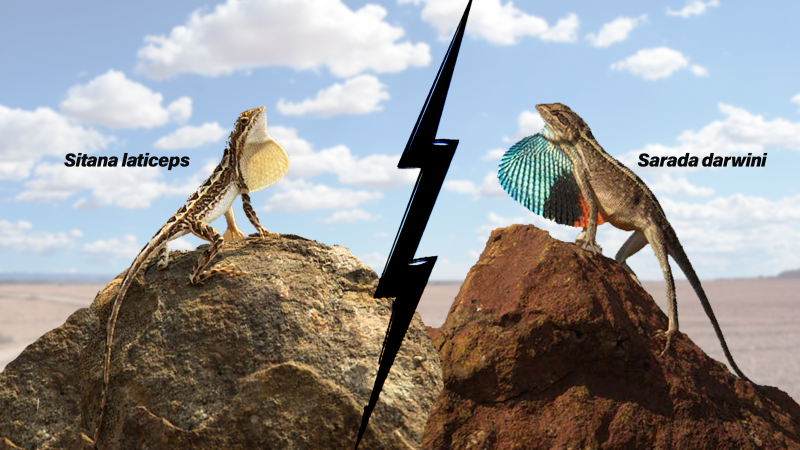
The fan-throated lizards: L- Sitana laticeps R - Sarada darwini (photos by Swapnil Pawar )
Shakespeare’s play, Comedy of Errors, is a humorous take on mistaken identities; however, such an error in nature is not so amusing and can even turn into potential combat - as seen between two species of lizards.
A research team from the Indian Institute of Science, Bengaluru, and the University of Minnesota, USA, have investigated how similarity in warning and courtship signals used by male lizards of two species — Sitana laticeps and Sarada darwini — can lead to harmful conflict and even combat between them. They found that the lizard species view each other as competitors for territory and mates, despite visible differences. This apparent confusion triggers aggression between males of these species, escalating to chasing and, at times, physical combat. Often, it is the smaller of the two species (Sitana laticeps) that pays the price of the brawl.
However, the researchers also posit that Sitana laticeps could be altering its signalling patterns to save itself from tragic consequences. They published their study in the journal Proceedings of Royal Society B.
As the name suggests, fan-throated lizards have a fan-like flap under their throats called dewlaps, which they use for courting females. In the presence of a female, the males perform dewlap flapping - rapid extension and retraction of dewlaps. Males are territorial, protecting a patch of real estate typically around a conspicuous display perch such as rocks and boulders that they defend fiercely from other males. Incidentally, they use the same dewlap flapping as a warning signal to ward off male intruders.
Sitana laticeps and Sarada darwini are two fan-throated lizard species found in western India. Of these, Sarada darwini typically inhabits the foothills of the Western Ghats, whereas Sitana laticeps is widely distributed across the Deccan plateau region. In select locations where the two regions meet, these two species overlap with each other. In the overlapping areas, males of these species can at times quarrel with each other.
“The fact that females of both species look almost indistinguishable and the remarkable similarity in male dewlap flagging behaviour likely makes it challenging for males of both species to distinguish between mates and rivals of their own and the other species,” says Mr Amod Zambre, first author of the study.
Interestingly, the dewlap of Sarada darwini is tri-coloured, whereas the dewlap of Sitana laticeps is plain white. In reality, there is no danger in having a male of the other species around during courtship since the mating is not physically compatible between two different species. However, the lizards don’t seem to be aware of it yet!
“Such large differences in colouration should in theory help to minimising conflict between species, but in our case, it seems like they may not necessarily help in minimising conflict between species. This is super interesting, and we are not sure why it is so,” says Mr Zambre. The ensuing aggression and physical combat due to the mistaken identity turn particularly dangerous for the smaller Sitana laticeps.
The researchers hypothesised that in order to avoid fights like these, Sitana laticeps might be altering their signalling behaviours. To test their theory, they collected lizards from three locations from the Western Ghats: one was inhabited only by Sarada darwini, second only by Sitana laticeps, and in the third site, both species thrived together closely (no more than ~15 km apart) and had similar arid grassland habitats. At each of these three locations, they estimated the densities of both males and females and recorded their morphological data, including sizes of male dewlaps. They also observed how often the males displayed courtship and aggressive behaviours towards females and males, respectively.
Their observations indicated that in the region where the two lizard species thrived together, Sitana laticeps’s dewlap flagging had changed in frequency compared to its counterpart in the region where they did not coexist with Sarada darwini. “Sitana laticeps co-occurring with Sarada darwini have smaller dewlaps and lower frequency of dewlap flagging. Thus, they have relatively lower intensity of courtship and aggression displays,” says Mr Zambre. However, the researchers did not notice such observable changes in the males of Sitana laticeps from the isolated regions, indicating that the presence of the other species and the resulting competition drove the smaller lizards to change their current signalling pattern.
If these signals diverge enough, Sarada darwini could interpret Sitana laticeps as belonging to a different species and leave it alone. Also, whether these changes in signals get established in the male population depends on how far the females accept these traits, which remains to be explored.
The researchers say that by avoiding harmful fights, one species might evolve differently. The notable point is that the behaviour changes only when it co-occurs with another species and not when living isolated. Such altered behaviours could be one of the ways in which the diversity of life forms around us could have originated.
This article has been run past the researchers, whose work is covered, to ensure accuracy.






